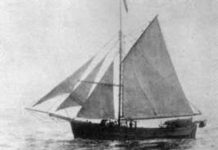
The Majoribanks family was the upper crust of English and Scottish society, the stern Sir Dudley Coutts Majoribanks the 1st Baron of Tweedmouth. A leading politician, he was a businessman and landowner, with interests in dog breeding. The third daughter of Majoribanks was Ishbel Maria, born on March 14, 1857. Her name was the Gaelic version of Isabelle, her mother’s name. Raised in a comfortable London, England home with four brothers and sisters, Ishbel was a precocious child, curious, studious and full of spirit. While her good education and status gave her great advantage, Ishbel placed great importance on the welfare of others, no matter their place in society.
Miss Majoribanks Became Lady Aberdeen
Politics fascinated young Ishbel and there was no shortage of political discussions with her father’s colleagues in her childhood home in Scotland. One of the visitors to the Majoribanks home caught Ishbel’s attention – John Campbell Hamilton-Gordon, the Earl of Aberdeen. The courtship was long. Lord Aberdeen, ten years her senior, was unsure of his desires. After several years, he realized his love for Ishbel, and they wed on November 7, 1877. Ishbel was now Lady Aberdeen, and her home was Haddo House, an expansive home on 1,400 acres in Aberdeenshire in northeast Scotland.
Encompassing several villages, the properties of Lord Aberdeen were home to hundreds of workers and their families. Ishbel started programs to raise the living standards of servants and tenants. Holding classes at the Household Club, servants could enjoy “a singing class by our head forester; a carving class led by our governess; a drawing class led by our nurse, and a home reading circle led by a neighbouring schoolmaster,” Ishbel was quoted by Doris French in “Ishbel and the Empire: A Biography of Lady Aberdeen”. The Club held regular musical events and readings.
Clubs Benefit Aberdeenshire Villagers
The villagers were offered different programs, with the Aberdeens building a school, offering “penny lunches” at another school, and constructing a small hospital with nursing staff. Organizing “work parties,” according to French, Ishbel also made sure the very poor were clothed and fed. Ishbel also began a club for servant girls called “Onward and Upward” which was so enjoyed that it grew to 8,280 members across Scotland. The young women studied basic subjects of history, geography and literature, plus homemaking skills of knitting, needlework and more.
Raising a family, the Aberdeens had five children; one died in infancy. The aristocratic couple travelled widely, the Aberdeens visiting Australia, New Zealand and Tasmania, and touring exotic Ceylon and India. Their world tour in 1890 included an extended visit to Canada.
Canadian Governor-General Lord Aberdeen
In 1893, Lord Aberdeen was named Governor-General of Canada. Lord and Lady Aberdeen moved into Rideau Hall in Ottawa. The vice-regals entered Canadian society “with an enthusiastic cordiality and whole-hearted sympathy which completely won the hearts of even the sturdiest Canadians,” said Electric Scotland in “Scots and Scots Descendant in America, Part V, Lady Aberdeen.” At their new Canadian home, the Aberdeens hosted dinners and gala balls, theatre and music performances, and participated in hockey and curling.
First President of National Council of Women in Canada
Intending to step back and observe Canadian society for a time, Ishbel was instead almost immediately captivated by a group organizing a women’s council. Within a month of arriving, Ishbel was one of the founding members and named first president of the National Council of Women of Canada. Also elected president of the International Council of Women in 1893, Ishbel held the post for almost 40 years.
Lady Aberdeen a Co-Founder of Victorian Order of Nurses
Hearing dreadful stories across Canada of women and children requiring medical help and receiving none in the late 1890s, Lady Aberdeen and the National Council of Women took strong note. Ishbel wrote of “stories of cases where young mothers and children had died, whist husbands and fathers were travelling many weary miles for the medical and nursing aid which might have saved them,” according to Victorian Order of Nurses Canada. The decision was made to form an order of nurses who would visit from home to home. The plan was announced on February 1, 1897, naming the agency “Victorian Order of Home Helpers” in honour of Queen Victoria’s Diamond Jubilee. Recognizing that the nurses were trained professionals, the name was soon changed to Victorian Order of Nurses.
While accepted by the Canadian government and citizens, there were objections against the VON from an unusual quarter: doctors. The physicians claimed the nurses would be a danger to the public. Judged as fear of competition plus perhaps prejudices against women in the era, the doctors were overruled, and the visiting nurses became a Canadian staple in health care.
Honorary Degree for Lady Aberdeen
In 1897, Lady Aberdeen was the first woman in Canada to receive an honorary university degree. Queen’s University in Kingston, Ontario awarded Ishbel the degree of Doctorate of Laws in 1897 for her good works. (She was also the first woman given honorary membership in the British Medical Association in 1909.)
When Governor-General Lord Aberdeen’s term was completed, a number of events were held to celebrate his and Ishbel’s five years in Canada. The family was given a collection of artworks created by the Women’s Art Association of Canada. Delighted, in a speech in the Senate Chamber on June 13, 1989, Ishbel said “As we look at these pictures… our thoughts will fondly travel again to the great Dominion, and will wander from East to West, fondly lingering on remembrances brought afresh to our minds by scenes from city and country life alike.”
Lord and Lady Aberdeen’s legacy was to transform the office of Governor-General from distant aristocrat to sincere concern for all Canadians. Lord Aberdeen’s next official posting was Lord Lieutenant of Ireland, and of course, Ishbel Maria Majoribanks Gordon, Lady Aberdeen, continued to strive for a better world. She died in April 1939 at age 82.
Sources:
- French, Doris, Ishbel and the Empire: A Biography of Lady Aberdeen, Dundurn Press, Toronto 1988.
- “Scots and Scots Descendant in America, Part V, Lady Aberdeen,” Electric Scotland
- “History – A Century of Caring,” Victorian Order of Nurses Canada
- “Former Governors General,” The Governor General of Canada






